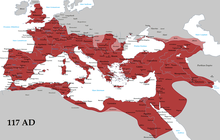Roman language
| Latin | |
|---|---|
| Lingua latīna | |

Latin inscription, in the Colosseum
|
|
| Pronunciation | [laˈtiːna] |
| Native to | |
| Ethnicity | Latins |
| Era | Vulgar Latin developed into Romance languages, 6th to 9th centuries; the formal language continued as the scholarly lingua franca of Catholic countries medieval Europe and as the liturgical language of the Catholic Church. |
| Latin alphabet | |
| Official status | |
|
Official language in
|
|
| Regulated by |
|
| Language codes | |
| ISO 639-1 | la |
| ISO 639-2 | |
| ISO 639-3 | |
| Glottolog | lati1261 |
| Linguasphere | 51-AAB-a |

Map indicating the greatest extent of the Roman Empire (c. 117 AD) and the area governed by Latin speakers (dark red). Many languages other than Latin were spoken within the empire.
|
|

Range of the Romance languages, the modern descendants of Latin, in Europe.
|
|
Latin (Latin: lingua latīna, IPA: [ˈlɪŋɡʷa laˈtiːna]) is a dead classical language belonging to the Italic branch of the Indo-European languages. The Latin alphabet is derived from the Etruscan and Greek alphabets, and ultimately from the Phoenician alphabet.
Latin was originally spoken in Latium, in the Italian Peninsula. Through the power of the Roman Republic, it became the dominant language, initially in Italy and subsequently throughout the Roman Empire. Vulgar Latin developed into the Romance languages, such as Italian, Portuguese, Spanish, French, and Romanian. Latin, Italian and French have contributed many words to the English language. Latin and Ancient Greek roots are used in theology, biology, and medicine.
...
Wikipedia
